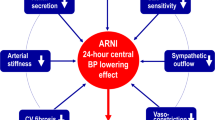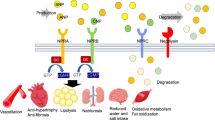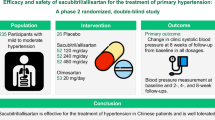Abstract
Hypertension is a major risk factor for cardiovascular morbidity and mortality. Effective control of elevated blood pressure (BP) has been shown to reduce this risk. Early studies of risk reduction assumed that the mechanism by which BP was lowered had little impact on the benefit obtained. Recent evidence, however, suggests that agents that inhibit the renin-angiotensin system may be particularly beneficial. The results of the recent Heart Outcomes Prevention Evaluation (HOPE) trial suggest that angiotensin-converting enzyme (ACE) inhibitors have a greater impact on cardiovascular morbidity and mortality than would be anticipated from their antihypertensive effects alone. Angiotensin receptor blockers, the other major class of antihypertensive drugs that inhibit the renin-angiotensin system, have not been widely tested in outcomes trials, but early results suggest that they are beneficial for controlling target organ damage that is related to hypertension. Furthermore, unlike ACE inhibitors, these agents have a side-effect profile that is similar to that of placebo. Based on their efficacy in controlling hypertension and their wider health benefits, together with minimal side effects, angiotensin II (A II) receptor blockers should be considered as first-line agents for the treatment of hypertension, particularly in patients with other cardiovascular risk factors. Preliminary evidence suggests that olmesartan, an A II receptor blocker currently being evaluated for approval for clinical use, may provide antihypertensive efficacy that is superior to other members of the class.
This is a preview of subscription content, access via your institution
Access options
Subscribe to this journal
Receive 12 digital issues and online access to articles
$119.00 per year
only $9.92 per issue
Buy this article
- Purchase on Springer Link
- Instant access to full article PDF
Prices may be subject to local taxes which are calculated during checkout




Similar content being viewed by others
References
Kannel WB . Fifty years of Framingham Study contributions to understanding hypertension J Hum Hypertens 2000 14: 83–90
Kannel WB . Blood pressure as a cardiovascular risk factor: prevention and treatment JAMA 1996 275: 1571–1576
MacMahon S et al. Blood pressure, stroke, and coronary heart disease. Part 1, Prolonged differences in blood pressure: prospective observational studies corrected for the regression dilution bias Lancet 1990 335: 765–774
Stamler J, Stamler R, Neaton JD . Blood pressure, systolic and diastolic, and cardiovascular risks. US population data Arch Intern Med 1993 153: 598–615
Collins R et al. Blood pressure, stroke, and coronary heart disease. Part 2, Short-term reductions in blood pressure: overview of randomised drug trials in their epidemiological context Lancet 1990 335: 827–838
SHEP Cooperative Research Group. Prevention of stroke by antihypertensive drug treatment in older persons with isolated systolic hypertension. Final results of the systolic hypertension in the elderly program (SHEP) JAMA 1991 265: 3255–3264
Dahlof B et al. Morbidity and mortality in the Swedish Trial in Old Patients with Hypertension (STOP-Hypertension) Lancet 1991 338: 1281–1285
MRC Working Party. Medical Research Council trial of treatment of hypertension in older adults: principal results BMJ 1992 304: 405–412
Staessen JA et al. Randomised double-blind comparison of placebo and active treatment for olderpatients with isolated systolic hypertension. The Systolic Hypertension in Europe (Syst-Eur) Trial Investigators Lancet 1997 350: 757–764
Perry HM Jr et al. Effect of treating isolated systolic hypertension on the risk of developing various types and subtypes of stroke: the Systolic Hypertension in the Elderly Program (SHEP) JAMA 2000 284: 465–471
UK Prospective Diabetes Study Group. Tight blood pressure control and risk of macrovascular and microvascular complications in type 2 diabetes: UKPDS 38 BMJ 1998 317: 703–713
Bakris GL et al. Preserving renal function in adults with hypertension and diabetes: a consensus approach. National Kidney Foundation Hypertension and Diabetes Executive Committees Working Group Am J Kidney Dis 2000 36: 646–661
Lazarus JM et al. Achievement and safety of a low blood pressure goal in chronic renal disease. The Modification of Diet in Renal Disease Study Group Hypertension 1997 29: 641–650
The sixth report of the Joint National Committee on Prevention, Detection, Evaluation, and Treatment of High Blood Pressure Arch Intern Med 1997 157: 2413–2446
Berlowitz DR et al. Inadequate management of blood pressure in a hypertensive population N Engl J Med 1998 339: 1957–1963
Cohen JS . Adverse drug effects, compliance, and initial doses of antihypertensive drugs recommended by the Joint National Committee vs the Physicians’ Desk Reference Arch Intern Med 2001 161: 880–885
Leenen FH et al. Patterns of compliance with once versus twice daily antihypertensive drug therapy in primary care: a randomized clinical trial using electronic monitoring Can J Cardiol 1997 13: 914–920
The Treatment of Mild Hypertension Research Group. The treatment of mild hypertension study: a randomized, placebo-controlled trial of a nutritional-hygienic regimen along with various drug monotherapies Arch Intern Med 1991 151: 1413–1423
Materson BJ et al. Single-drug therapy for hypertension in men. A comparison of six antihypertensive agents with placebo. The Department of Veterans Affairs Cooperative Study Group on Antihypertensive Agents N Engl J Med 1993 328: 914–921
The CONSENSUS Trial Study Group. Effects of enalapril on mortality in severe congestive heart failure. Results of the Cooperative North Scandinavian Enalapril Survival Study (CONSENSUS) N Engl J Med 1987 316: 1429–1435
Pfeffer MA et al. Effect of captopril on mortality and morbidity inpatients with left ventricular dysfunction after myocardial infarction. Results of the survival and ventricular enlargement trial N Engl J Med 1992 327: 669–677
The SOLVD Investigators. Effect of enalapril on survival inpatients with reduced left ventricular ejection fractions and congestive heart failure N Engl J Med 1991 325: 293–302
Yusuf S et al. Effects of an angiotensin-converting-enzyme inhibitor, ramipril, on cardiovascular events in high-riskpatients. The Heart Outcomes Prevention Evaluation Study Investigators N Engl J Med 2000 342: 145–153
Chiou KR et al. Randomized, double-blind comparison of irbesartan and enalapril for treatment of mild to moderate hypertension Chung Hua I Hsueh Tsa Chih 2000 63: 368–376
Burnier M, Brunner HR . Angiotensin II receptor antagonists Lancet 2000 355: 637–645
Benz J et al. Valsartan, a new angiotensin II receptor antagonist: a double-blind study comparing the incidence of cough with lisinopril and hydrochlorothiazide J Clin Pharmacol 1997 37: 101–107
Elliott WJ . Double-blind comparison of eprosartan and enalapril on cough and blood pressure in unselected hypertensivepatients. Eprosartan Study Group J Hum Hypertens 1999 13: 413–417
Larochelle P et al. Effects and tolerability of irbesartan versus enalapril inpatients with severe hypertension. Irbesartan Multicenter Investigators Am J Cardiol 1997 80: 1613–1615
Malmqvist K, Kahan T, Dahl M . Angiotensin II type 1 (AT1) receptor blockade in hypertensive women: benefits of candesartan cilexetil versus enalapril or hydrochlorothiazide Am J Hypertens 2000 13: 504–511
Roca-Cusachs A et al. A randomized, double-blind comparison of the antihypertensive efficacy and safety of once-daily losartan compared to twice-daily captopril in mild to moderate essential hypertension Acta Cardiol 1997 52: 495–506
Smith DHG, Neutel JM, Morgenstern P . Once-daily telmisartan compared with enalapril in the treatment of hypertension Adv Ther 1998 15: 229–240
Corea L et al. Valsartan, a new angiotensin II antagonist for treatment of essential hypertension: a comparative study of the efficacy and safety against amlodipine Clin Pharmacol Ther 1996 60: 341–346
Kloner RA et al. Comparative effects of candesartan cilexetil and amlodipine inpatients with mild systemic hypertension. Comparison of Candesartan and Amlodipine for Safety, Tolerability and Efficacy (CASTLE) Study Investigators Am J Cardiol 2001 87: 727–731
Lacourciere Y et al. A comparison of the efficacies and duration of action of the angiotensin II receptor blockers telmisartan and amlodipine Blood Press Monit 1998 3: 295–302
Ruilope LM . Renoprotection and renin-angiotensin system blockade in diabetes mellitus Am J Hypertens 1997 10: S325–S331
Wilson TW, Lacourciere Y, Barnes CC . The antihypertensive efficacy of losartan and amlodipine assessed with office and ambulatory blood pressure monitoring. Canadian Cozaar Hyzaar Amlopidine Trial Study Group CMAJ 1998 159: 469–476
Park JB, Intengan HD, Schiffrin EL . Reduction of resistance artery stiffness by treatment with the AT1-receptor antagonist losartan in essential hypertension J Renin Angiotensin Aldosterone Sys 2000 1: 40–45
Schiffrin EL, Park JB, Intengan HD, Touyz RM . Correction of arterial structure and endothelial dysfunction in human essential hypertension by the angiotensin receptor antagonist losartan Circulation 2000 101: 1653–1659
Malmqvist K et al. Regression of left ventricular hypertrophy in human hypertension with irbesartan J Hypertens 2001 19: 1167–1176
Thurmann PA et al. Influence of the angiotensin II antagonist valsartan on left ventricular hypertrophy inpatients with essential hypertension Circulation 1998 98: 2037–2042
Tedesco MA et al. Effects of losartan on hypertension and left ventricular mass: a long-term study J Hum Hypertens 1998 12: 505–510
Li D, Saldeen T, Romeo F, Mehta JL . Oxidized LDL upregulates angiotensin II type 1 receptor expression in cultured human coronary artery endothelial cells: the potential role of transcription factor NF-kappaB Circulation 2000 102: 1970–1976
Koike H . New pharmacologic aspects of CS-866, the newest angiotensin II receptor antagonist Am J Cardiol 2001 87: C33–C36
Strawn WB et al. Inhibition of early atherogenesis by losartan in monkeys with diet-induced hypercholesterolemia Circulation 2000 101: 1586–1593
Hedner T et al. A comparison of the angiotensin II antagonists valsartan and losartan in the treatment of essential hypertension Am J Hypertens 1999 12: 414–417
Lacourciere Y, Asmar R . A comparison of the efficacy and duration of action of candesartan cilexetil and losartan as assessed by clinic and ambulatory blood pressure after a missed dose, in truly hypertensivepatients. A placebo-controlled, forced titration study. Candesartan/Losartan study investigators Am J Hypertens 1999 12: 1181–1187
Monterroso VH et al. Use of ambulatory blood pressure monitoring to compare antihypertensive efficacy and safety of two angiotensin II receptor antagonists, losartan and valsartan Adv Ther 2000 17: 117–132
Oparil S et al. An elective-titration study of the comparative effectiveness of two angiotensin II-receptor blockers, irbesartan and losartan. Irbesartan/Losartan Study Investigators Clin Ther 1998 20: 398–409
Oparil S et al. Comparative efficacy of olmesartan,losartan, valsartan, and irbesartan in the control of essential hypertension J Clin Hypertens 2001 3: 283–291
Author information
Authors and Affiliations
Corresponding author
Rights and permissions
About this article
Cite this article
Oparil, S. Comparative antihypertensive efficacy of olmesartan: comparison with other angiotensin II receptor antagonists. J Hum Hypertens 16 (Suppl 2), S17–S23 (2002). https://doi.org/10.1038/sj.jhh.1001394
Published:
Issue Date:
DOI: https://doi.org/10.1038/sj.jhh.1001394
Keywords
This article is cited by
-
Preparation of olmesartan medoxomil solid dispersion with sustained release performance by mechanochemical technology
Drug Delivery and Translational Research (2022)
-
A randomized, double-blind, four-arm parallel-group study of the efficacy and safety of azelnidipine and olmesartan medoxomil combination therapy compared with each monotherapy in Japanese patients with essential hypertension: the REZALT study
Hypertension Research (2009)
-
Comparative efficacy of valsartan and olmesartan in mild-to-moderate hypertension: Results of 24-hour ambulatory blood pressure monitoring
Advances in Therapy (2005)
-
Antihypertensive efficacy of olmesartan compared with other antihypertensive drugs
Journal of Human Hypertension (2002)



